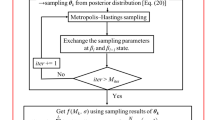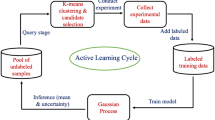Abstract
Machine learning of the creep rupture life dataset, which consists of test temperatures, stresses and rupture lives, received less attention in the community due to numerous physics-based and empirical models already available for the prediction of the creep rupture life, and a limited number (typically about 10 to 40) of available creep rupture life data points considered to be too small to be trained for the reliable prediction. A simple data analytics approach was developed for the quick and reliable assessment of the creep rupture life. The proposed approach involves linear regression as a major algorithm and the four features [two generic features (temperature (T) and stress (σ)) and two physics-informed features (ln σ and −1/T)], and exhibited superior creep rupture life predictions (validated by the 41 creep datasets of ferritic Cr steels) without any violation of creep phenomenology and data overfitting. In particular, the proposed approach was extremely useful to assess the fidelity of the Laron–Miller relation for a given creep rupture life dataset and to find an optimum Larson–Miller constant that minimizes a deviation from the ideal Larson–Miller relation. An analytical model was also developed based on curve fitting of Larson–Miller parameters calibrated by the optimum Larson–Miller constant. The proposed analytical model gave additional improvement in creep rupture life prediction, particularly for creep datasets, of which creep rupture lives were slightly less predicted by the data analytics approach. The two proposed models provided a synergistic effect in creep rupture life prediction when interactively used.
Graphical Abstract













Similar content being viewed by others
References
F.C. Monkman, An empirical relationship between rupture life and minimum creep rate in creep-rupture tests. Proc. ASTM 56, 593–620 (1956)
B. Choudhary, E.I. Samuel, J. Nucl. Mater. 412, 82–89 (2011)
E.I. Samuel, B. Choudhary, D.R. Palaparti, M. Mathew, Proc. Eng. 55, 64–69 (2013)
F.R. Larson, J. Miller, Trans. Am. Soc. Mech. Eng. 74, 765–771 (1952)
F. Furillo, S. Purushothaman, J. Tien, Scr. Metall. 11, 493–496 (1977)
K.-H. Grote, H. Hefazi (eds.), Springer Handbook of Mechanical Engineering, 2nd edn. (Springer Nature, Switzerland, 2021), p. 174
S.S. Manson, A.M. Haferd, A Linear Time-Temperature Relation for Extrapolation of Creep and Stress-Rupture Data (NACA, Washinton, 1953)
J. Zhao, D.-M. Li, Y.-Y. Fang, J. Pressure Vessel Technol. 132, 064502 (2010)
R.L. Orr, O.D. Sherby, J.E. Dorn, Correlations of Rupture Data for Metals at Elevated Temperatures (Institue of Engineering Research University of California, Berkeley, 1953)
K. Kimura, K. Sawada, H. Kushima, Creep deformation, rupture strength, and rupture ductility of grades T/P92 steels, in Proceedings of the ASME 2014 Symposium on Elevated Temperature Application of Materials for Fossil, Nuclear, and Petrochemical Industries. Seattle, 25-27 March 2014 (ASME, New York, 2014), pp. 193–201
M.E. Kassner, M.-T. Pérez-Prado, Prog. Mater Sci. 45, 1–102 (2000)
B. Wilshire, A. Battenbough, Mater. Sci. Eng. A 443, 156–166 (2007)
M. Yang, Q. Wang, X.-L. Song, J. Jia, Z.-D. Xiang, Int. J. Mater. Res. 107, 133–138 (2016)
Q. Wang, M. Yang, X. Song, J. Jia, Z. Xiang, Metall. Mater. Trans. A. 47, 3479–3487 (2016)
S.C. Kim, J.-H. Shim, W.-S. Jung, Y.S. Choi, Met. Mater. Int. 25, 713–722 (2019)
B. Wilshire, P. Scharning, Scripta Mater. 56, 701–704 (2007)
P.F. Tortorelli, H. Wang, K.A. Unocic, M.L. Santella, J.P. Shingledecker, V. Cedro III, Long-term creep-rupture behavior of Inconel® 740 and Haynes® 282, in Proceedings of the ASME 2014 Symposium on Elevated Temperature Application of Materials for Fossil, Nuclear, and Petrochemical Industries. Seattle, 25–27 (ASME, New York, 2014), pp. 29–36
W. Harrison, M. Whittaker, S. Williams, Materials 6, 1118–1137 (2013)
B. Wilshire, P. Scharning, R. Hurst, Mater. Sci. Eng. A 510, 3–6 (2009)
M. Whittaker, W. Harrison, Mater. High Temp. 31, 233–238 (2014)
S. Williams, M. Bache, B. Wilshire, Mater. Sci. Technol. 26, 1332–1337 (2010)
Y. Yoo, C. Jo, C. Jones, Mater. Sci. Eng. A 336, 22–29 (2002)
Y. Liu, J. Wu, Z. Wang, X.-G. Lu, M. Avdeev, S. Shi, C. Wang, T. Yu, Acta Mater. 195, 454–467 (2020)
S. Xiang, X. Chen, Z. Fan, T. Chen, X. Lian, J. Market. Res. 18, 268–281 (2022)
Y. Tan, X. Wang, Z. Kang, F. Ye, Y. Chen, D. Zhou, X. Zhang, J. Gong, J. Market. Res. 21, 4745–4760 (2022)
B.O. Kong, M.S. Kim, B.H. Kim, J.H. Lee, Met. Mater. Int. (2022). https://doi.org/10.1007/s12540-022-01312-7
D. Shin, Y. Yamamoto, M.P. Brady, S. Lee, J.A. Haynes, Acta Mater. 168, 321–330 (2019)
J. Wang, Y. Fa, Y. Tian, X. Yu, J. Market. Res. 13, 635–650 (2021)
X.-C. Zhang, J.-G. Gong, F.-Z. Xuan, Int. J. Fatigue 148, 106236 (2021)
H. Han, W. Li, S. Antonov, L. Li, Comput. Mater. Sci. 205, 111229 (2022)
C. Wang, X. Wei, D. Ren, X. Wang, W. Xu, Mater. Des. 213, 110326 (2022)
A.K. Verma, J.A. Hawk, L.S. Bruckman, R.H. French, V. Romanov, J.L. Carter, Metall. Mater. Trans. A 50, 3106–3120 (2019)
Y.S. Yoo, I.S. Kim, D.H. Kim, C.Y. Jo, H.M. Kim, C.N. Jones, The application of neural network to the development of single crystal superalloys, in Proceedings of the 10th International Symposium on Superalloys, ed. by K.A. Green, T.M. Pollock, H. Harada, T.E. Howson, R.C. Reed, J.J. Schirra, S, Walston. Superalloys 2004, Seven Springs, 19-23 September 2004 (TMS, Pittsburgh, 2004), pp. 942–950
Z. Abdallah, V. Gray, M. Whittaker, K. Perkins, Materials 7, 3371–3398 (2014)
X.W. Zhu, H.H. Cheng, M.H. Shen, J.P. Pan, Adv. Mater. Res. 791–793, 374–377 (2013)
Z. Guo, Z. Song, D. Huang, X. Yan, Met. Mater. Int. 28, 2972–2986 (2022)
P. Wan, H. Yu, F. Li, P. Gao, L. Zhang, Z. Zhao, Met. Mater. Int. 28, 2498–2512 (2022)
Y. Zeng, Y. Pan, N. Wang, J. Chen, X. Cai, Met. Mater. Int. (2022). https://doi.org/10.1007/s12540-022-01313-6
J. Yu, I.Y. Moon, H.W. Jeong, H.W. Lee, J.H. Kim, S.-H. Kang, Met. Mater. Int. 28, 3016–3032 (2022)
S. Dutta, P.S. Robi, Met. Mater. Int. 28, 2884–2897 (2022)
Acknowledgements
This research was supported by the Nano and Material Technology Development Program through the National Research Foundation of Korea (NRF) funded by Ministry of Science and ICT (2021M3A7C2089771 and 2021M3H4A1A04091999).
Author information
Authors and Affiliations
Corresponding author
Ethics declarations
Conflict of interest
The authors declare that they have no conflict of interest.
Additional information
Publisher's Note
Springer Nature remains neutral with regard to jurisdictional claims in published maps and institutional affiliations.
Rights and permissions
Springer Nature or its licensor (e.g. a society or other partner) holds exclusive rights to this article under a publishing agreement with the author(s) or other rightsholder(s); author self-archiving of the accepted manuscript version of this article is solely governed by the terms of such publishing agreement and applicable law.
About this article
Cite this article
Lee, C., Lee, T. & Choi, Y.S. Simple Data Analytics Approach Coupled with Larson–Miller Parameter Analysis for Improved Prediction of Creep Rupture Life. Met. Mater. Int. 29, 3149–3160 (2023). https://doi.org/10.1007/s12540-023-01445-3
Received:
Accepted:
Published:
Issue Date:
DOI: https://doi.org/10.1007/s12540-023-01445-3




